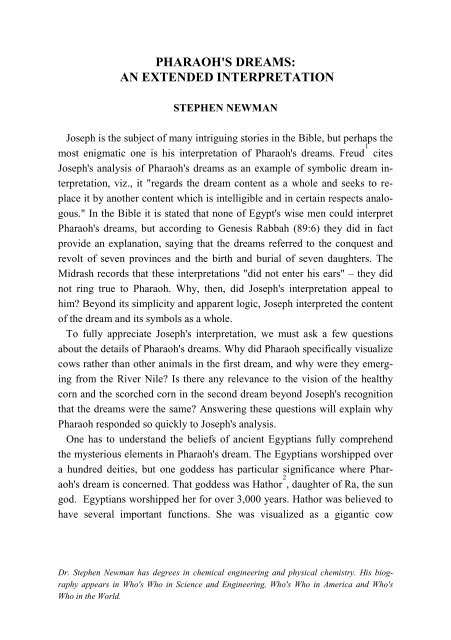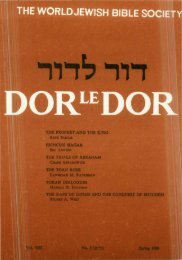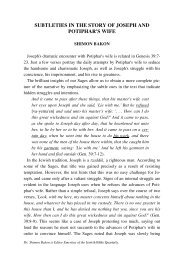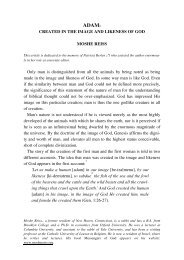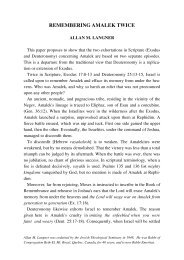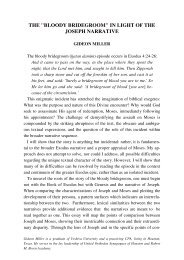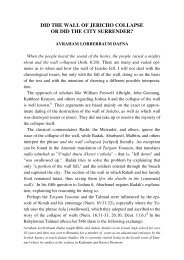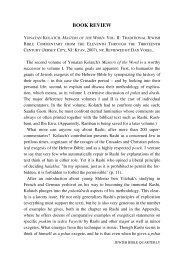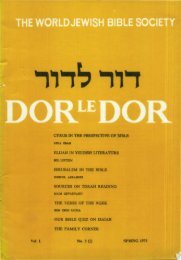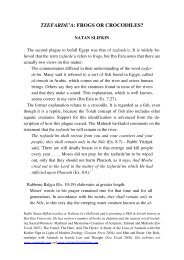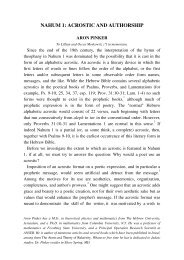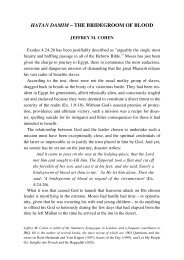Pharaoh's Dream - Jewish Bible Quarterly
Pharaoh's Dream - Jewish Bible Quarterly
Pharaoh's Dream - Jewish Bible Quarterly
You also want an ePaper? Increase the reach of your titles
YUMPU automatically turns print PDFs into web optimized ePapers that Google loves.
PHARAOH'S DREAMS:<br />
AN EXTENDED INTERPRETATION<br />
STEPHEN NEWMAN<br />
Joseph is the subject of many intriguing stories in the <strong>Bible</strong>, but perhaps the<br />
most enigmatic one is his interpretation of <strong>Pharaoh's</strong> dreams. Freud 1<br />
cites<br />
Joseph's analysis of <strong>Pharaoh's</strong> dreams as an example of symbolic dream interpretation,<br />
viz., it "regards the dream content as a whole and seeks to replace<br />
it by another content which is intelligible and in certain respects analogous."<br />
In the <strong>Bible</strong> it is stated that none of Egypt's wise men could interpret<br />
<strong>Pharaoh's</strong> dreams, but according to Genesis Rabbah (89:6) they did in fact<br />
provide an explanation, saying that the dreams referred to the conquest and<br />
revolt of seven provinces and the birth and burial of seven daughters. The<br />
Midrash records that these interpretations "did not enter his ears" – they did<br />
not ring true to Pharaoh. Why, then, did Joseph's interpretation appeal to<br />
him? Beyond its simplicity and apparent logic, Joseph interpreted the content<br />
of the dream and its symbols as a whole.<br />
To fully appreciate Joseph's interpretation, we must ask a few questions<br />
about the details of <strong>Pharaoh's</strong> dreams. Why did Pharaoh specifically visualize<br />
cows rather than other animals in the first dream, and why were they emerging<br />
from the River Nile? Is there any relevance to the vision of the healthy<br />
corn and the scorched corn in the second dream beyond Joseph's recognition<br />
that the dreams were the same? Answering these questions will explain why<br />
Pharaoh responded so quickly to Joseph's analysis.<br />
One has to understand the beliefs of ancient Egyptians fully comprehend<br />
the mysterious elements in <strong>Pharaoh's</strong> dream. The Egyptians worshipped over<br />
a hundred deities, but one goddess has particular significance where <strong>Pharaoh's</strong><br />
dream is concerned. That goddess was Hathor 2<br />
, daughter of Ra, the sun<br />
god. Egyptians worshipped her for over 3,000 years. Hathor was believed to<br />
have several important functions. She was visualized as a gigantic cow<br />
Dr. Stephen Newman has degrees in chemical engineering and physical chemistry. His biography<br />
appears in Who's Who in Science and Engineering, Who's Who in America and Who's<br />
Who in the World.
254<br />
STEPHEN NEWMAN<br />
stretched over the heavens, taking care of the Milky Way, which the Egyptians<br />
called the Nile in the Sky. Her most vital function for the Egyptians was<br />
causing the Nile to overflow its banks each year. This provided fertile soil on<br />
which crops (e.g., corn) could grow. Without such annual flooding Egypt<br />
would have been a famine-ridden wasteland. The most striking relevance of<br />
the goddess to <strong>Pharaoh's</strong> dream is that in some instances she would appear as<br />
seven Hathors. 3<br />
In this form she was often present at births, foretold the future,<br />
and was associated with the Nile's inundation and the subsequent grain<br />
harvest.<br />
Being familiar with the goddess and her attributes, Pharaoh recognizes the<br />
wise intent of Joseph's advice. The seven fat cows represent the fertility of<br />
the land, embodied in the Egyptian symbol of seven Hathors. This concept is<br />
reinforced by the seven full ears of corn in the second dream. In addition, the<br />
cows emerging from the river also indicate that they stand for the goddess<br />
Hathor, caretaker of the Nile. Joseph's interpretation thus drew upon Egyptian<br />
symbols well known to Pharaoh and used them effectively to explain the<br />
whole dream. That is why it rang true in the ears of Pharaoh.<br />
NOTES<br />
1. S. Freud, The Interpretation of <strong>Dream</strong>s (New York: Macmillan, 1900) ch. 2, p. 1.<br />
2. B. Lesko, The Great Goddesses of Egypt (Stillwater, OK: University of Oklahoma Press,<br />
1999).<br />
3. G. Massey, The Natural Genesis (London, 1883), reprinted 2007, Part 2, p.1. See also J. Hastings,<br />
Encyclopedia of Religion and Ethics (Whitefish, MT: Kessinger Publishing, 2003) p. 711.<br />
JEWISH BIBLE QUARTERLY


